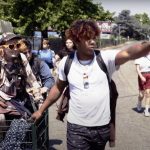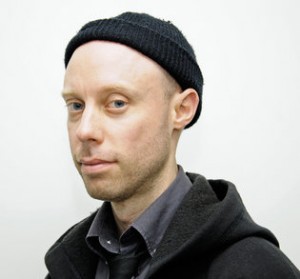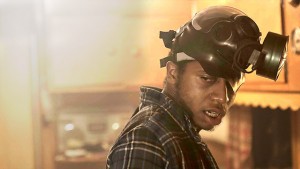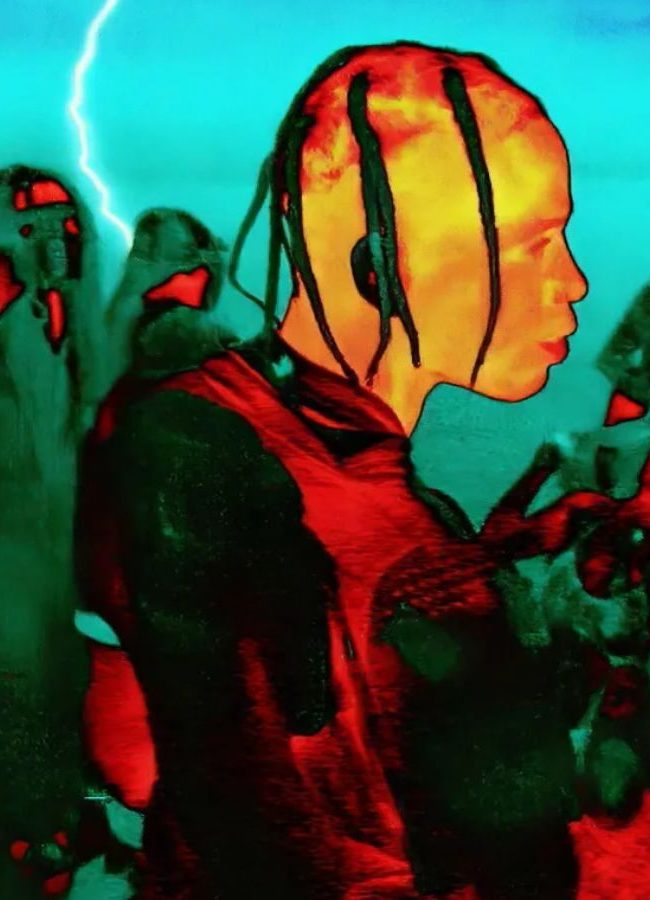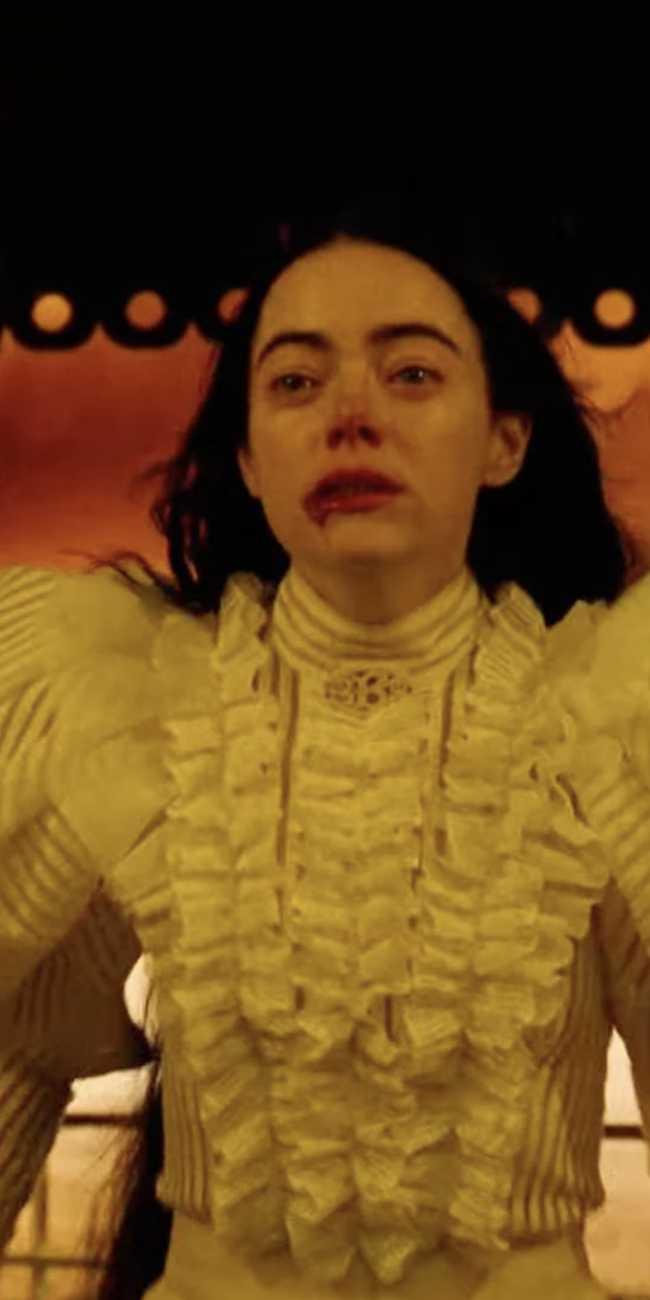A Conversation With Joel Potrykus (THE ALCHEMIST COOKBOOK)
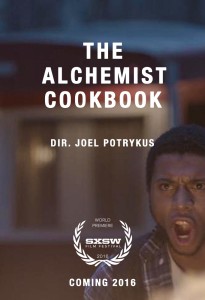 (Charles Poekel caught up with Joel Potrykus at BAM Cinemafest regarding his latest film The Alchemist Cookbook. The result is the following chat which is one of the best interviews you’ll read all year! Potrykus’ film is available NOW in a pay-what-you-want format.)
(Charles Poekel caught up with Joel Potrykus at BAM Cinemafest regarding his latest film The Alchemist Cookbook. The result is the following chat which is one of the best interviews you’ll read all year! Potrykus’ film is available NOW in a pay-what-you-want format.)
I caught up with Joel Potrykus (Buzzard, Ape) after his newest film, The Alchemist Cookbook, played BAM Cinemafest in June. The film follows an outcast (Sean) living in the woods of Michigan who makes amateurish attempts at alchemy and reckless conjurings of evil in a genre best described as “WTF?” (in the best way possible). In his SxSW wrap-up, Michael Tully wrote:
Joel Potrykus may have abandoned the grit and grime of urban life in order to shack up in the woods, but he sure as shit didn’t leave behind his penchant for weird-ass punk-infused shenanigans! While I ultimately don’t know what this movie means — is going off the grid a bad idea? has the world made all of us insane? is Satan realer than Bigfoot? — the performances by Ty Hickson and Amari Cheatom and Potrykus’s assured filmmaking made this one of the more original films I saw at this year’s fest. Which is to say = yes, please!
Hammer to Nail: What first attracted you to this idea? Was it the location? The genre?
Joel Potrykus: It started off when me and my girlfriend/producer were driving on a street in Grand Rapids, a city where you kind of know a lot of people. And we thought we saw this old friend of ours, Roland, walking down the street like a zombie. And we drove by him real slow and we were like, “Maybe that wasn’t him?” Then we turned around and pulled off to the side of the street and just watched him. And it was him – and we rolled down the window and were like, “Hey Roland!” and he just turned and looked at us and didn’t say a thing and then just walked into a house that was right there. And I was like, “What was THAT?” And Ashley [Young] and I thought that we had seriously seen a doppelganger and that this guy was like some creation of satan or something, out to do malicious harm and he just didn’t know who were were and didn’t know what to say. So I started to write this doppelganger script and then just one thing led to another. It was supposed to be a doppelganger out in the woods story. Usually I just have a bunch of ideas for a script and I just shove them all together so I had an idea about an alchemist, and then I had this weird doppelganger thing, and then I just started kind of throwing them all together. And then at some point the story just takes over and the character does what they want. So that’s how it started off. But I had been wanting to make a movie out in the woods for a long time. All through high school I made little crappy The Evil Dead ripoffs in the woods and it was time to do something real and give my love to The Evil Dead and just do it in my own style, and you know, in a much different way than The Evil Dead.
HtN: And that’s set in Michigan too, right?
JP: Yeah! That’s why when I was sixteen and I finally saw The Evil Dead it was like, “Oh my gosh Michigan guys made this movie in the woods???” This is all I want to do for the rest of my life is make movies in the woods in Michigan. So for a lot of guys in Michigan I know that’s like their biggest influence – The Evil Dead. I assumed everybody’s influence was that until I started going to festivals and then realized The Evil Dead wasn’t the only film influencing people [laughs].
HtN: Let’s talk about influences for minute: Michigan, Esham. What were some of the other influences for you on this?
JP: Specifically it was like what if we took some of the ideas and the location of The Evil Dead, but what if Jim Jarmusch had to make that movie? That’s basically where it started stylistically. I have go-to movies I always watch ahead of time, and for this it was, let me see, Michael Haneke for one – everything he does. Specifically The Seventh Continent. I love the way he frames things and just lets the audience put the story together by themselves really slowly. So I’d say Haneke, and Jim Jarmusch and Sam Raimi and then I’m always influenced by music – by rap music, punk music. I listened to Come On Pilgrim by the Pixies while I wrote actually, and I feel like someday I want somebody to mashup parts of the movie with that album. He [Sean] even secretly quotes Pixies lyrics in the movie, during one of his spell-casting, you know, talking to the forest. Something about that album…I just wanted to capture the mood of that album in a film. So I always listen to something different when I write and I just listened to that album on repeat and felt like I just wanted to make that album into a movie.
HtN: On the surface Alchemist seems like a very different movie than Buzzard or Ape. But kind of immediately I felt Sean’s character was very much in line with the other characters you’ve explored. I might not go so far as call him him a slacker, but in his pursuit of short cuts he kind of has this juvenile naivety about him. He’s clearly not talented in his pursuit and early on you have a bunch of great humorous moments when he messes things up – like the scene where he’s stacking the logs.
JP: Yeah, it’s weird because starting off I wanted to make something totally different than Buzzard and Ape. Just like, take out the white people, take out the city, but after a while you start to realize you’re kind of almost making the same movie over and over it just looks a lot different. And on this one…you know these movies I make…like in Christmas, Again it’s one person’s perspective and you don’t cut back and forth to any other characters, so we’re really only getting the story from one person’s eyes. And I just subconsciously write these characters who are delusional, who are angry, who feel disenfranchised and frustrated and it’s never intentional – that’s just how they come out. I don’t know where that comes from because I thought we’d made something totally different and then after we showed it the first time people were like, “Yeah, that was very Potrykus.” And I was like, “Oh man! Wild.” Most of those things are just subconscious, you know, it’s just kind of embedded in what I do. But Sean is definitely someone who’s kind of against the system and trying to do his own things and really doesn’t know….I guess I’m just putting myself in all these movies. A dude who’s just stumbling along trying to do his best and get away from other people interfering with his work. I guess it’s just me frustrated and on my own [laughs].
HtN: Well I think it’s a pretty universal feeling to be honest. Whether we admit it or not.
JP: Yeah, I’ve just never had the desire to write a character who was successful and doing good things for the world and being positive – that just doesn’t interest me at all. I want to see the people who are frustrated and cast out. What are they up to? What do they think? What do those people eat for breakfast and dinner? And how do they sleep? And how do they get by? That’s just kind of…in what I do I guess.
HtN: Speaking of eating and sleeping…At the BAM screening David Reilly asked you about the eating motif in your work — the Bugles and spaghetti in Buzzard and your interest in the mundane. Do we ever see Sean sleeping?
JP: We see him sleeping once in a kind of makeshift fort covered in Christmas lights.
HtN: Right [laughs].
JP: Sean to me is like all my characters – stunted in their social development and their maturity. Sean I saw as an angry little boy. And I thought that character wouldn’t sleep in in their bed but rather he would make himself a little fort out of a blanket and sticks and wrap himself in christmas lights to feel safe and secure. We never see him sleeping in an actual bed. There’s one part where he wakes up in his bathtub but he’s probably more just passed out from pain. But I specifically never wanted to see Sean’s bed. He’s just sleeping wherever he’s at and whenever he wants. So he has no routine sleeping or eating schedule. He’s just kind of living according to what his body tells him to do at that moment.
HtN: What’s nice about that is we never really get a sense of time, which I think for Sean’s headspace is really fitting for him. We don’t know over how many days this takes place. It could be like 3 days or it could be 3 weeks…
JP: That’s another thing too. I wanted to disrupt the sense of time and place. A lot of people get hung up on when does this story take place – like what year? The same thing with Buzzard; is it the 90’s, the 80’s, the early 2000’s? And with this one it was the same – I just wanted to get rid of all of those things that give you specific ideas of when it takes place. So there’s no cell phones and no modern cars. It’s important to me, especially with this one, just to throw people off and not give them a real sense of structure… there’s no kind of anchors in reality, you don’t really even know what’s real. And that was kind of the goal with this. I wanted to finally make almost a poem or puzzle and have people put it together however they wanted to and not give too many direct interpretations or specifics. I’d rather have them…you know you go see a painting at a museum it’s not like you have the artist standing right there, “So this is what’s happening right here, this is what I see.” Man, that takes away all the beauty of the painting if you have the artist sitting there telling you exactly what it means. I wanted to make something that the audience would be able to just sit there and watch – that’s why sometimes Q&A’s are a little tricky because I’m afraid to give away too much and ruin someone else’s interpretations of what they just saw.
HtN: And I think that plays really well into the whole thing with Sean’s pills, and fever dreams, and what is reality. Not really having any concept of time and space…
JP: In that way it’s similar to Christmas, Again – not about a guy taking a bunch of pills to get crazy, but a guy who goes off his pills and tries to get a sense of reality and ground himself. I think that’s infinitely more interesting than someone who starts taking pills and starts to get all weird and messed up in the head. I think it’s stronger to show someone not relying on that and watching what happens as a result.
HtN: Based on what you just said about the movie being only what’s on the screen I won’t bother even asking you what the pills were – because if you wanted us to know you would’ve told us.
JP: Exactly. I try to give just the smallest amount of information needed and let people pull their own meanings from it. I don’t want to give away any specific ailments that he may have mentally.
HtN: You said a really fascinating thing at the BAM screening about the sounds in the woods not being what’s Sean’s hearing but what he’s thinking…
JP: Yeah, I don’t want us to think that everything is in his head. Otherwise I’d just have shots of him holding his head and shaking off these voice or something. I want us to question whether these things are really happening in the forest around him because he’s reacting as if he hears them and not just in his head. Sometimes Sean reacts to them sometimes Sean doesn’t. But I just want people to constantly question – you know, throw the sense of reality off a little bit. Which is much easier to do than just simply tell the audience that these sounds and voices are all in the character’s head.
HtN: From a production standpoint, as far as resources go, how was this different from your other films and what kind of effect did that have on the film?
JP: This was a huge jump step. Because Ape was basically me and Josh [Burge] for 90 percent of that shoot, just bouncing around the city getting shots. And Buzzard had maybe like a 5 or 6 person crew. And this was the first time I ever had like a hair and makeup person and an actual gaffer, and an art department. These are the things I’ve always done myself and just…I kind of just took it on myself to make all the props, put together the wardrobe, put on makeup if need be. So this definitely felt like the first time I was making a “real movie” where we had a bigger budget and, like, an Alexa camera, as opposed to a Canon DSLR. And we had interns, and it was like a big thing. And it freaked me out for a while – that’s not how I typically want to make movies. It took about a week to get with the program and just realize that these people weren’t here to just bug me and ask me a hundred different questions, they were there to do the work that I’d normally do so I could focus on directing. So once I was able to figure that out and relaxed a little bit, it was awesome. They just made this bubble around me and I didn’t have to worry about schedules and if props were gonna be there or, you know, if the actor was going to get picked up – somebody actually picked up the actor everyday. I loved it man. Now I understand why people make movies with 25 people on set. I get it now. I think it works for some projects and some it doesn’t.
HtN: People have said your films have a kind of a punk ethos, one that’s easily romanticized. Do you ever worry that if you get too big you might lose that?
JP: [Laughs] So for the last 3 days I’ve been editing behind the scenes footage, for like special features, and I’m like, “Man, I’m totally gonna lose my cred after people see how many people were on-set. And how we have craft services.” There’s nothing punk rock about this production at all. I mean, I guess if you’re like Michael Bay, or even, you know, Jeff Nichols, he’d be like, “man, that’s a pretty bare-bones crew.” But to me it felt like,” Jeez, this is what I’ve been trying to get away from all these years. All these big sets with all these big lights and expensive gear.” So, part of me did feel a little bit like I’m getting away from my roots.
HtN: Like what would the 13-year old Joel Potrykus think of this?
JP: [Laughs] Yeah, that’s exactly what I was thinking I was like, ‘What if there’s a dude in film school who watches Buzzard and Ape and is like, “Yeah man, I could do this! Just round up a few friends and make this movie. I can’t wait to see The Alchemist Cookbook!” and then like, “Oh man, why are there so many names in the credits?! This isn’t what I was supposed to be inspired by.’ I do feel a little bit like a phony like that, that I’ve expanded my roster so big – but the budget was small enough that it still felt like we pulled it off pretty punk. But I don’t ever call myself a “punk filmmaker” that’s just something I think a lot of people put on there because there’s loud music and it’s a small crew and we’re kind of doing these crazy movies but I’ve never been one to wave that flag and proclaim myself the new voice of punk filmmaking – I think that’s kind of bullshit.
HtN: And it’s all relative–
JP: Yeah, I really just want to make movies that an 18-yr old film student can watch and be like, “I can do that.” Because those are the movies that really inspired me to become a filmmaker–the ones I saw, like Stranger than Paradise –I can make that movie. Gummo – this is great, I love it, I can make that movie. But then you see, like, last night I watched Midnight Special – no, I could not make that movie. Nope, I don’t have those resources – I don’t know if I ever want those resources. This does not make me want to go make a movie. But then, you know, you see, what did I just see?…Broadway Danny Rose for the first time. Which is a big production but it’s such economical storytelling. I want to tell a story that’s small like that. Like Louie – it’s the same thing with Louie. Watching Louie I think man, his storytelling is just so inspirational. Everything is there for a specific reason. So economical. It just blows my mind how these guys do that.
HtN: One thing I love about your films is how risky some of your decisions feel. Making a film at all is risky and I feel like some filmmakers automatically shy away from risk since there’s just so much risk already involved. Do you think about risk at all?
JP: That’s just something I’ve never once thought about. I’m not working for a studio, there’s nobody breathing down my neck with their money asking me, “Where’s the romantic interest?” I just make the exact movie I would want to see. So for me it’s not even taking risks it’s just…we can do what we want and we have the freedom. And I take it for granted that maybe my tastes are a little bit eskew. I see something like The Lobster and I think it’s infinitely more risky than what we’re doing because they have a bigger budget and big stars and are telling this incredibly cryptic story that my mom would never want to watch even if she knew Colin Farrell, a good-looking guy, was in it.
But then my producer the other day said something I’d never heard him say – we were just… gushing back and forth to each other thanking each other, and he kind of summed it up, he said, “You helped me realize that I need to ask myself ‘what could I do,’ rather than ‘what should I do.’” And I was like, jeez! I gotta write that one down. That’s pretty profound. [Laughs] I guess that’s how I make movies – by seeing what could we do rather than what should we do. I never thought about an audience or who’s gonna like it. Joel Hodgson, from Mystery Science Theater 3000, said something once like, “We don’t ask ourselves, ‘will anyone get this?’ we say to ourselves, ‘the right people will get this.” I remember when I was like 13 I was like, ‘”Oh yeah! That’s what I want to do.” That’s just all kinda subconscious. I never really think about the audience or how it’s gonna perform financially or anything like that. I just want to do something different and mash up a bunch of different ideas and see what happens, that’s all.
– Charles Poekel (@Chaakles)





